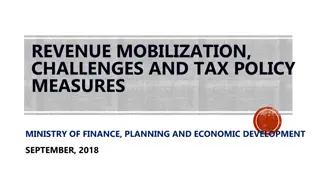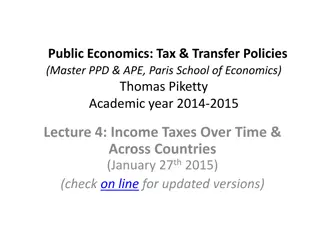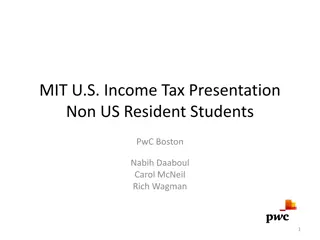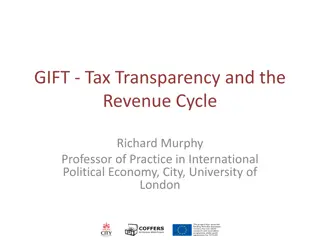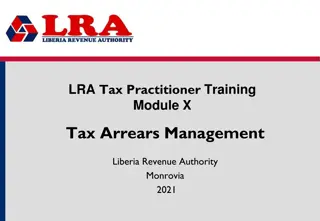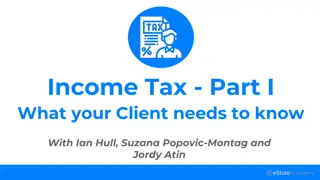Understanding Tax Implications on Investors and Investment Strategies
Explore how the recent tax bill impacts investors, comparing corporate and individual tax rates, investment strategies in corporate form, tax implications of interest income and capital gains, considerations for qualifying dividends, long-term gains, REITs, MLPs, and private REIT structures. Learn about tax deductions for MLPs and REITs, rules for private REIT ownership, and asset allocations for private REITs.
Uploaded on Sep 28, 2024 | 0 Views
Download Presentation

Please find below an Image/Link to download the presentation.
The content on the website is provided AS IS for your information and personal use only. It may not be sold, licensed, or shared on other websites without obtaining consent from the author. Download presentation by click this link. If you encounter any issues during the download, it is possible that the publisher has removed the file from their server.
E N D
Presentation Transcript
Impact of Tax Bill on Investors NYSSCPA July 19, 2018
Corporate vs. Individual Effect of Rate Change Corporate 21% Individual 37% Due to individual rates being almost double corporate rates, should investments be made in corporate form? Two traps Personal Holding Company Accumulated Earnings Tax
Corporate vs. Individual Key Points Corporation can get tax benefit of any investment expenses incurred Defer the distribution of income Goal is to die before distributing any income and heirs get a step up in basis; Compound higher after tax earnings while in corporate form
Corporate vs. Individual Interest Income and Short term Capital gains Earn $100 Individual Keep $59.2 after tax 37% + 3.8% Corporate Keep $79; distribute $79; shareholder keeps 60.198 at 23.8% rate Corporate is slightly better, and if there were investment expenses they would be deductible by corporation and make the comparison even more favorable
Corporate vs. Individual Qualifying Dividends, Long Term Capital Gains, REIT and MLP While the corporate rate is lower, if distributed the individual retains less through the corporation Only generate this type of income in corporate form if it is definite that the funds will not be distributed
MLPs and REITs MLP & REIT Distributions received are subject to the IRC Sec 199A 20% deduction Effective tax rate on distributions would be: 80% of 37% = 29.6% + 100% of 3.8% = 3.8% Total effective rate = 33.4%
Private REITs REIT Structure 5 or fewer taxpayers can t own more than 50% of stock and There must be at least 100 shareholders Attribution rules apply in determining the above rules the same rules that are used for personal holding companies, except There is no attribution between partners of a partnership
Private REITs REIT 75% of assets and 75% of its gross income could be related to mortgages on real estate There could be an additional amount of assets that produce interest income All of the dividend distributions would qualify for the 20% deduction
Mortgage Investors Mortgages are yielding 3.5% Assume a 50 b.p. management fee Net return 3% If held directly or in an LP 40.8% tax on 3.5%= 1.428 in tax Investors keeps 1.572% If held in a REIT 33.4% tax on $3 = 1.002 in tax Investors keep 1.9 A 27% After tax increase!!
Swaps Trap for Investors? Swaps Prior to Act New swap payments were deductible under either IRC Sec. 162 or Sec. 212 Traders Took deduction under Sec. 162 Investors Took deduction under Sec. 212 Deduction was subject to 2% of AGI limitation
Swaps Trap for Investors? Swaps Impact of Act All IRC Sec. 212 deductions subject to the 2% of AGI cap have been repealed Swap expenses for investors should not be deductible Issues Whipsaw Netting?
Interest Expense Business Interest Expense Net interest expense is limited as a deduction to 30% of adjusted taxable income Leveraged funds could be negatively impacted by these new rules
Interest Expense Business Interest Expense Solutions Effectively borrow money in transactions that do not produce interest expense for tax purposes Swaps-(Doubles down on Trader/Investor issue) Short sales Are short expenses interest for these purposes? Options
Interest Expense Business Interest Expense Option Spreads Box Spread A zero coupon loan Cash is generated at maturity the amount of cash generated plus a carrying charge is paid back No risk to price movement of underlying position Securities are put up as collateral and cash is withdrawn Resulting loss on the transaction is a trading loss
Opportunity Zones Opportunity Zones Government enacted IRC Secs. 1400Z-1 and 1400Z-2 Purpose was to encourage investments in economically depressed areas of the country Gains from the sale of capital gain property may be deferred if the gains are invested in Opportunity Zone funds Gains from the investment can be tax free if held for at least 10 years
Opportunity Zones Opportunity Zones Deferral of gain No recognition of deferred gain until the earlier of Disposition of opportunity zone investment, or December 31, 2026 Amount of deferred gain to be recognized If investment was held for more than 5 years, then asset will have a basis of 10% of the deferred gain; If investment was held for more than 7 years, the asset will have a basis of 15% of the deferred gain; If not sold by December 31, 2026 there is a deemed sale for the lesser of The deferred gain, or The fair market value of the property on December 31, 2026
Opportunity Zones Opportunity Zones Examples Assume that Irene sells anything for a gain of $1,000,000 and forms a partnership that qualifies as a qualified opportunity fund, and contributes $1,000,000 to the fund. 1 After 5 years, Irene sells the fund for $5,000,000. Sales Price $5,000,000 Basis Gain Recognized $4,900,000 The gain is composed of $900,000 of the net deferred gain after the basis bump and $4,000,000 of gain from the new investment 100,000
Opportunity Zones Opportunity Zones Examples 2- December 31, 2026 no sale and investment held for at least 7 years FMV = $5,000,000 Deemed Sales Price$1,000,000 Basis Gain Recognized $ 850,000 Only the deferred gain of $1,000,000 less 15% is recognized in 2026 because there was no sale of the fund 150,000
Opportunity Zones Opportunity Zones Examples 3 - December 31, 2026 no sale and investment held for at least 7 years FMV = $750,000 Deemed Sales Price $750,000 Basis 150,000 Gain Recognized $600,000 Since the investment went down in value, the amount of deferred gain is reduced by the loss in value. The 15% increase in basis is retained and only $600,000 of the original $1,000,000 gain has to be recognized.
Opportunity Zones Opportunity Zones Examples 4 - Investment held for more than 10 years and sold for $5,000,000 Sales Price Basis Gain Of course the appropriate percentage of the deferred gain has already been recognized in 2026, but all of the appreciation on the qualified fund investment is earned tax-free. $5,000,000 $5,000,000 0
Opportunity Zones Comparison to Other Favored Investments Transaction Opportunity Zone Sec 1202 stock Sec. 1031 Deferral of Gain? Amount invested Property to Invest Depressed Area Tax on NEW Profits 0 0 LT Gain Rate Minimum Holding 10 years Amount forgiven Unlimited Yes No Yes Only Gain N/A Anything Real Estate All Proceeds 5 years $10 million, or 10x basis no time limit N/A
CIRCULAR 230 DISCLOSURE Pursuant to the rules of professional conduct set forth in Circular 230, as promulgated by the United States Department of the Treasury, nothing contained in this communication was intended or written to be used by any taxpayer for the purpose of avoiding penalties that may be imposed on the taxpayer by the Internal Revenue Service, and it cannot be used by any taxpayer for such purpose. No one, without our express prior written permission, may use or refer to any tax advice in this communication in promoting, marketing, or recommending a partnership or other entity, investment plan or arrangement to any other party. For discussion purposes only. This work is intended to provide general information about the tax and other laws applicable to retirement benefits. The author, his firm or anyone forwarding or reproducing this work shall have neither liability nor responsibility to any person or entity with respect to any loss or damage caused, or alleged to be caused, directly or indirectly by the information contained in this work. This work does not represent tax, accounting, or legal advice. The individual taxpayer is advised to and should rely on their own advisors
Impact of Tax Bill on Investors NYSSCPA July 19, 2018
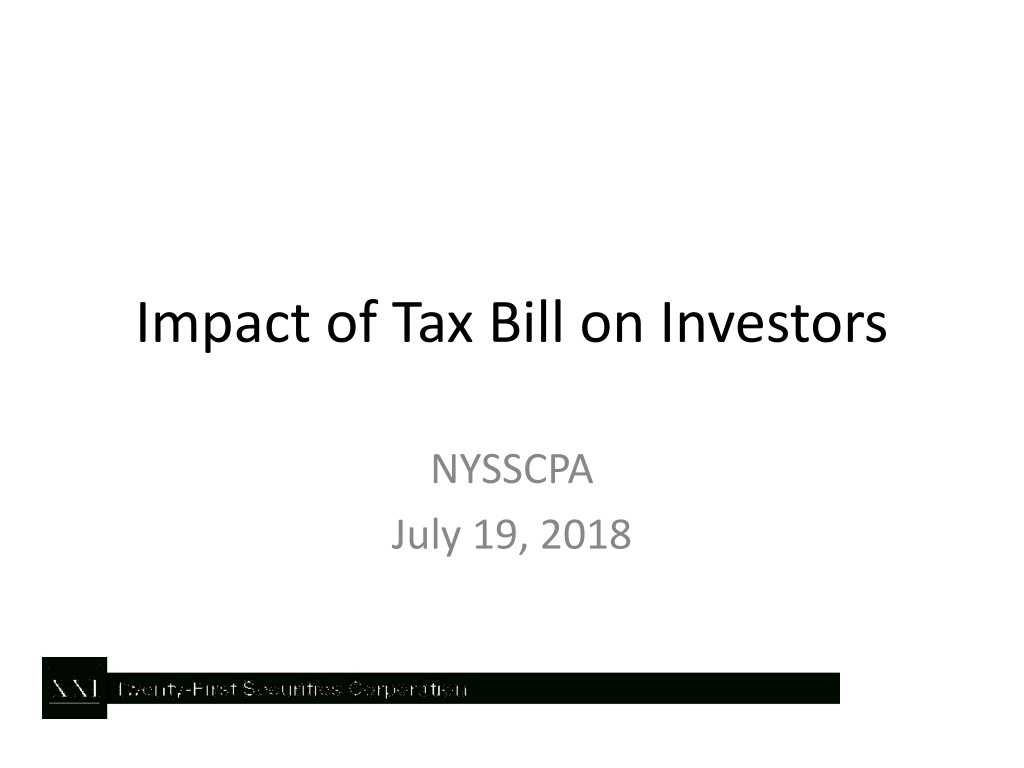


![Town of [Town Name] Real Estate Tax Rates and FY 2024 Budget Summary](/thumb/62211/town-of-town-name-real-estate-tax-rates-and-fy-2024-budget-summary.jpg)






